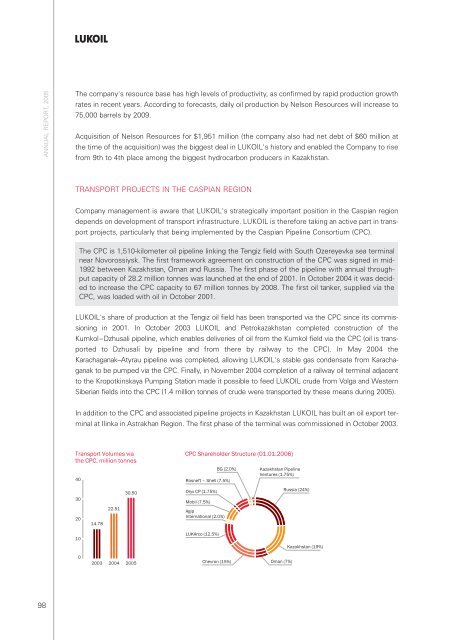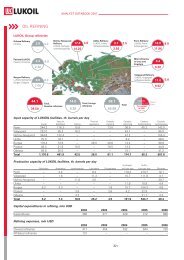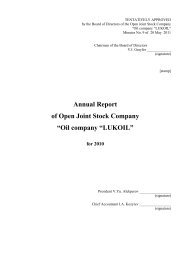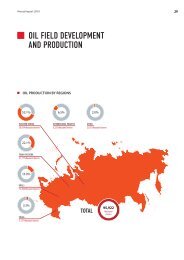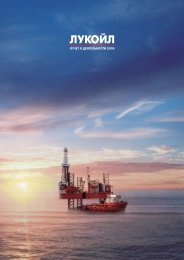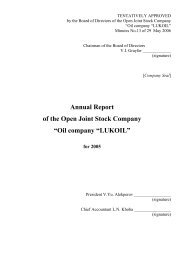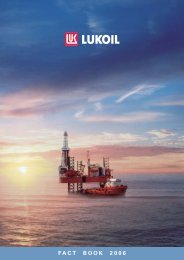ANNUAL REPORT 2005 - Lukoil
ANNUAL REPORT 2005 - Lukoil
ANNUAL REPORT 2005 - Lukoil
Create successful ePaper yourself
Turn your PDF publications into a flip-book with our unique Google optimized e-Paper software.
<strong>ANNUAL</strong> <strong>REPORT</strong>, <strong>2005</strong><br />
The company's resource base has high levels of productivity, as confirmed by rapid production growth<br />
rates in recent years. According to forecasts, daily oil production by Nelson Resources will increase to<br />
75,000 barrels by 2009.<br />
Acquisition of Nelson Resources for $1,951 million (the company also had net debt of $60 million at<br />
the time of the acquisition) was the biggest deal in LUKOIL's history and enabled the Company to rise<br />
from 9th to 4th place among the biggest hydrocarbon producers in Kazakhstan.<br />
TRANSPORT PROJECTS IN THE CASPIAN REGION<br />
Company management is aware that LUKOIL's strategically important position in the Caspian region<br />
depends on development of transport infrastructure. LUKOIL is therefore taking an active part in transport<br />
projects, particularly that being implemented by the Caspian Pipeline Consortium (CPC).<br />
The CPC is 1,510-kilometer oil pipeline linking the Tengiz field with South Ozereyevka sea terminal<br />
near Novorossiysk. The first framework agreement on construction of the CPC was signed in mid-<br />
1992 between Kazakhstan, Oman and Russia. The first phase of the pipeline with annual throughput<br />
capacity of 28.2 million tonnes was launched at the end of 2001. In October 2004 it was decided<br />
to increase the CPC capacity to 67 million tonnes by 2008. The first oil tanker, supplied via the<br />
CPC, was loaded with oil in October 2001.<br />
LUKOIL's share of production at the Tengiz oil field has been transported via the CPC since its commissioning<br />
in 2001. In October 2003 LUKOIL and Petrokazakhstan completed construction of the<br />
Kumkol–Dzhusali pipeline, which enables deliveries of oil from the Kumkol field via the CPC (oil is transported<br />
to Dzhusali by pipeline and from there by railway to the CPC). In May 2004 the<br />
Karachaganak–Atyrau pipeline was completed, allowing LUKOIL's stable gas condensate from Karachaganak<br />
to be pumped via the CPC. Finally, in November 2004 completion of a railway oil terminal adjacent<br />
to the Kropotkinskaya Pumping Station made it possible to feed LUKOIL crude from Volga and Western<br />
Siberian fields into the CPC (1.4 million tonnes of crude were transported by these means during <strong>2005</strong>).<br />
In addition to the CPC and associated pipeline projects in Kazakhstan LUKOIL has built an oil export terminal<br />
at Ilinka in Astrakhan Region. The first phase of the terminal was commissioned in October 2003.<br />
Transport Volumes via<br />
the CPC, million tonnes<br />
40<br />
CPC Shareholder Structure (01.01.2006)<br />
BG (2.0%)<br />
Rosneft – Shell (7.5%)<br />
Kazakhstan Pipeline<br />
Ventures (1.75%)<br />
30<br />
20<br />
14.78<br />
22.51<br />
30.50<br />
Oryx CP (1.75%)<br />
Mobil (7.5%)<br />
Agip<br />
International (2.0%)<br />
Russia (24%)<br />
10<br />
LUKArco (12.5%)<br />
Kazakhstan (19%)<br />
0<br />
2003<br />
2004<br />
<strong>2005</strong><br />
Chevron (15%)<br />
Oman (7%)<br />
98


